Remember you have to be a member of the N Gauge Society to purchase our kits
Kit 30: Gresley D113 Full Brake
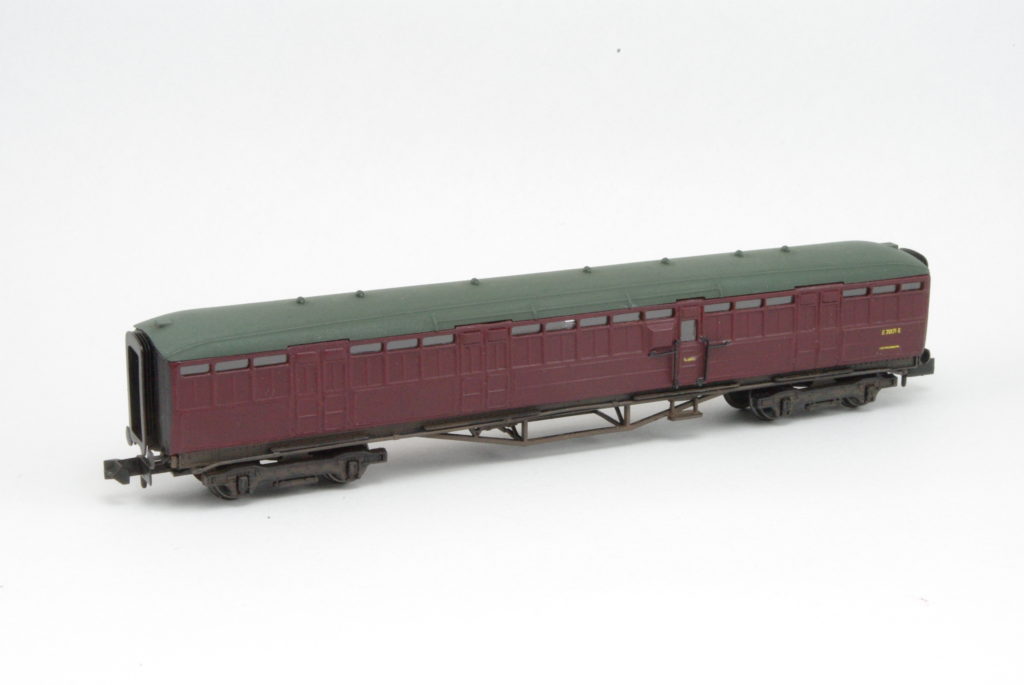
- NGSK0300
- era 4-7
- decals included but also available separately
- difficulty intermediate
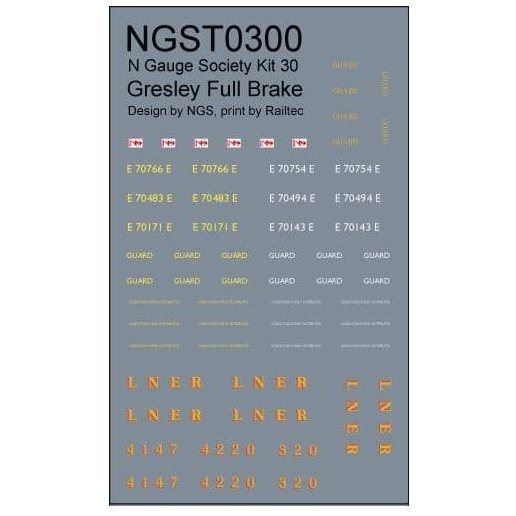
The Gresley full brakes were introduced in 1924; some survived in revenue use well into the 1970s, a few even longer in internal use, and a number have been preserved. These vehicles were seen all over the country, especially in BR days, and a number were built or converted for racing pigeon traffic. The chosen model represents later coaches with angle iron trussing and 8ft heavyweight Gresley bogies. The diagrams represented are D113 (last 3 only, built 1934), D245 (with racks for pigeons, built 1940/43), and D260 (same as last 3 of D113, built 1938/40/43).
Kit 31: BR Weltrol
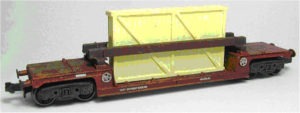
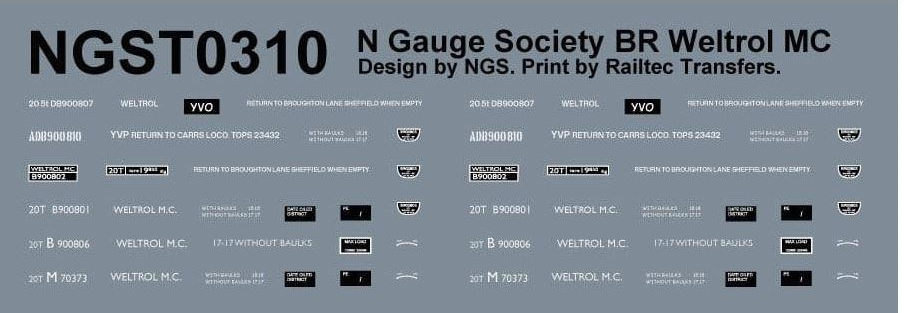
- NGSK0310
- era 5-9
- decals NGST 310
- difficulty intermediate
The kit includes Society 5’6” Plateback bogies (but does not include the crated load shown in the picture, which is available separately from the Society Shop – code NGSK0311).
Many different types were built, mainly in the 1950s, but, as they were lightly used, they lasted a long time, with a few still in service in internal use. There were 22 diagrams for different lengths and loads covering a total of 107 wagons, though some differed only in brake or bearing type. The chosen Weltrol MC prototype was one of the more common, with 22 built. It was based on an earlier LMS design and is one of the shorter ones with a square-shaped well. Unlike many other Weltrols, the floor was load-bearing so it could carry vehicles, which is one reason for its popularity as a departmental wagon.
Kit 32: GWR Macaw B

- NGSK0320
- era 3-5
- decals included but also available separately
- Difficulty intermediate
This kit represents a departure from normal practice for the Society in that the wagon body is made from laser cut wood, with a brass etch to provide brake detail. It runs on the Society’s own plateback bogies. The prototype was produced in substantial numbers by the GWR from 1907 to 1946 and many were inherited by BR.
Kit 33: Railtrack PNA Wagon

- NGSK0330
- era 9
- decals=included
- difficulty beginners
In the late 1990s Railtrack converted 250 former tank wagons into PNA open spoil carriers. 44 of them used Gloucester pedestal suspension. Of these, 22 were fitted with evenly spaced bodyside ribs, while the other 22 had a larger gap between the ribs above each axlebox. The kit is a twin pack, enabling one of each variant to be built, with self coloured green body mouldings, one piece black chassis, wheels, couplers and transfers. The picture shows weathered versions of completed models.
Kit 35: KPA Hopper, JJA/HQA Autoballaster
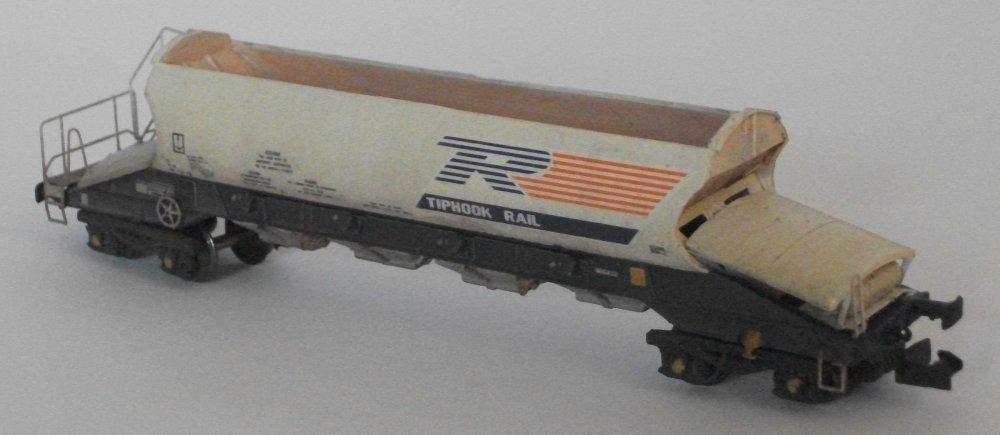
- NGSK0350 Tiphook PIA/KPA Aggregate Hopper Wagon
- NGSK0351 Railtrack JJA Autoballaster (converted from KPA)
- NGSK0352 Railtrack HQA Autoballaster (new build)
- NGSK0353 Network Rail HQA Autoballaster (new build)
- era 8-9
- decals included
- difficulty advanced
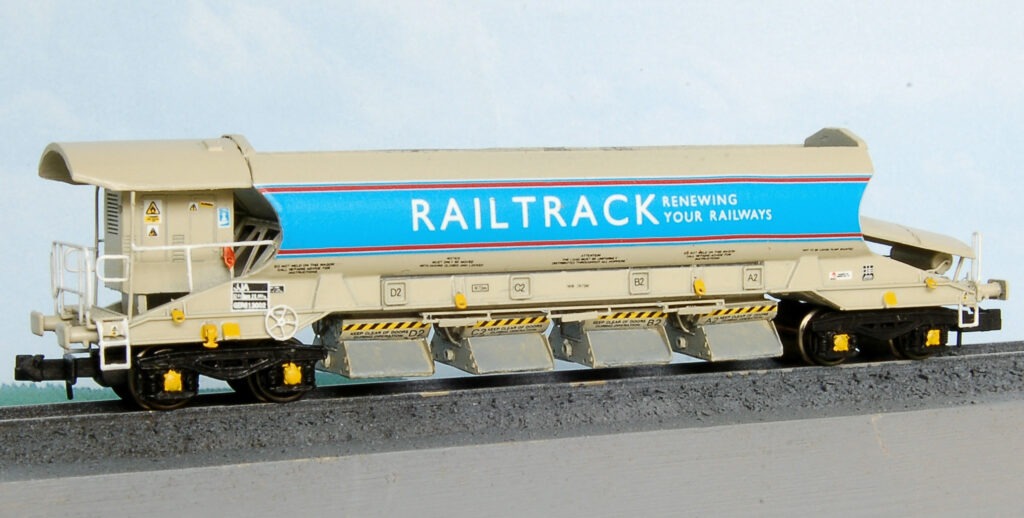
In 1988, 50 hoppers (originally coded PIA, then KPA) were built for Tiphook Rail in response to growth in the construction industry. They saw service around the network with Tarmac, RMC and Foster Yeoman, among others. In the mid 1990’s, prototype discharge gear was fitted to enable them to operate in five-vehicle sets as Autoballasters, in place of ageing Seacow and Dogfish wagons. The success of the project saw further conversions, and the purchase by Railtrack and subsequently Network Rail of considerable numbers of new wagons to an almost identical design. This kit comes in the following four versions:
Kit 36: BR Shock Wagons – Open & Van
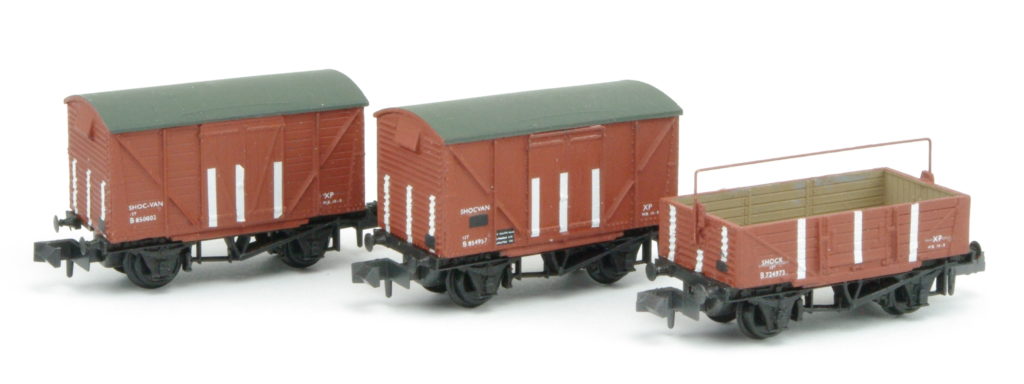
- NGSK0360
- era 4-7
- decals NGST0360
- difficulty beginner
British Railways built large numbers of shock-absorbing vans and open wagons in the early 1950s to its own designs, some remained in revenue use to the end of the 1970s. Certain fragile goods such as ceramics, bottles, and biscuits were susceptible to damage during shunting. The wagon body was connected to the chassis by means of springs on the outside of the solebars, thus absorbing more of the ‘shock’ of rough shunting than just the buffers.
The distinctive white stripes on the sides and ends were to indicate to shunters that the wagons were shock-absorbing, presumably so that they were handled with greater care. BR used both plywood and planking for the van sides, so both these types are catered for with alternative sides to make either one or the other. Shown are both Van variants and the Open (models and picture by Richard Bardsley).
Kit 37a: TTA Chemical Tanker

- NGSK0370
- era 7-9
- decals NGST0370
- difficulty advanced
In 1967/8, Charles Roberts Ltd built a batch of chemical tankers for Tank Rentals Ltd, with a through vacuum pipe, to TOPS code TTB. They were later refurbished and reclassified TTA. Both ICI Mond and Associated Octel used them to transport liquid chlorine. These tankers were built with smaller diameter barrels than the more common petrochemical tankers of the same TOPS code, and were painted white with an orange band to denote their hazardous contents.
This kit was originally based around a Farish TTA wagon, which was used as a chassis donor. A moulded brick bund wall is included, which allowed the unused tank to be used for a static depot fuel tank as a scenic accessory. Since the Farish wagon became unavailable, the kit is now supplied with a Peco chassis.
The body is moulded in self-coloured plastic so that minimal painting is required. Etched brass accessories are included. A comprehensive sheet of decals is included covering early and late ICI chlorine, Associated Octel and Hays chlorine, ICI sodium hypochlorite and caustic soda, plus two other variants for sulphuric acid and molasses.
Kit 38: BR Borail
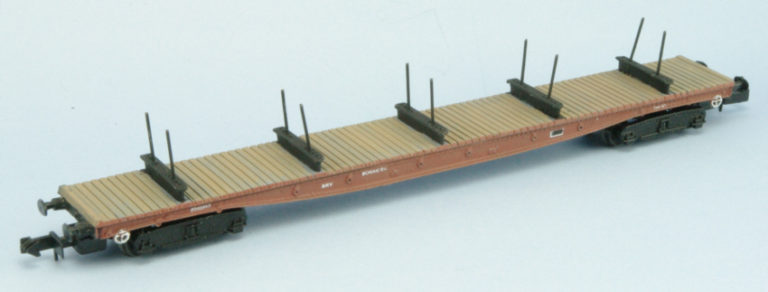
- NGSK0380
- era 5-7
- decals included
- difficulty intermediate
This kit builds a Borail EB or a Borail MB, or, if the bolsters are omitted, a Borail EC. They were built 1959-61 and lasted until rebuilt with air brakes in the late 70s (kit 39).
Kit No. 39: BR Mullet
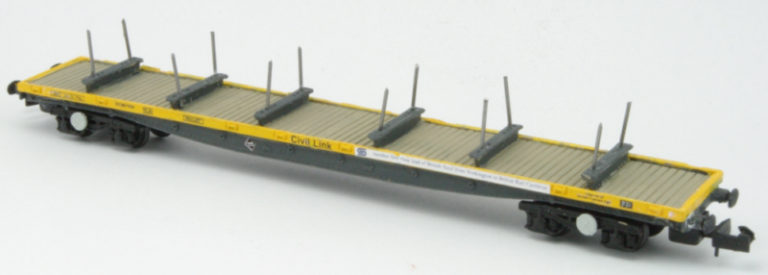
- NGSK0390
- era 7-9
- decals included
- difficulty intermediate
In the late 1970s, most of the Borails (see NGK038) were rebuilt and named Mullets. This ex-Parkwood kit is supplied with NGS Y25 bogies, decals and additional detailing.